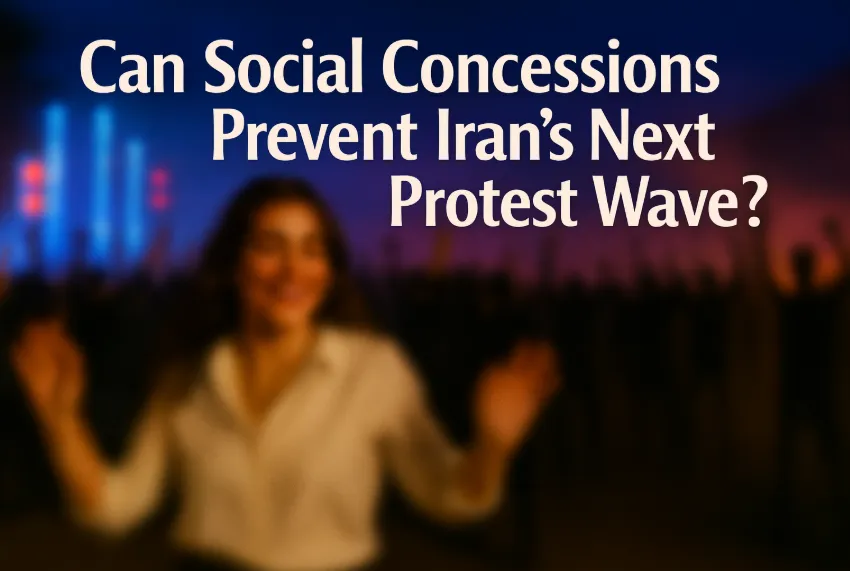
The Islamic Republic is walking a fragile line. In recent months, it has eased some social restrictions—loosening enforcement of mandatory hijab and permitting high-profile concerts—in an apparent effort to project stability and reduce the risk of renewed protests. The strategy seems intended to send two simultaneous messages: to domestic audiences, that society remains calm and aligned with the state and that limited freedoms are possible without the need for another uprising; and to international observers, that the regime is not on the verge of collapse. Yet beneath the surface, debate among analysts, activists, and ordinary citizens is intensifying: will these gestures be enough to stave off unrest, or will they embolden the very collective spirit the regime fears?
The dynamics of protest in Iran are well established. Uprisings in 2017, 2019, and 2022 erupted from a combustible mix of economic hardship, inequality, frustration with broken promises, elite divisions, and the rise of collective action language—slogans, hashtags, graffiti—that transformed private grievances into public defiance. All of these conditions remain in place today, and in many ways they are more acute: inflation is harsher, daily life more precarious, and Iran’s regional and international standing weaker. Yet despite widespread blackouts, water shortages, and economic pain, no uprising on the scale of earlier protests has erupted. One possible explanation lies in the regime’s tactics. Rather than doubling down on repression and social crackdowns—as it did in previous cycles—the state has opted for limited concessions and symbolic freedoms, hoping to defuse tensions by channeling public energy into controlled outlets.
But these gestures are not genuine reforms. Reformist thinkers inside Iran openly admit that the country’s youth, in particular, have moved far beyond the notion of reform and that their demands are far more radical than what political factions dare to propose. At the same time, the concessions remain temporary and cosmetic. Powerful, self-styled hardline enforcers still confront women and girls in public spaces, while authorities shut down cafes and restaurants for live music or hijab violations, keeping cultural life tightly policed. These “same old” restrictions underscore the limits of any apparent loosening, reminding citizens that structural change is off the table.
This strategy, however, carries profound risks. Temporary relaxations can backfire if citizens see them as signs of retreat, boosting confidence in their collective power to demand more. By implying that some freedoms are possible, the regime risks raising expectations it cannot sustain. While concerts or relaxed hijab enforcement may ease discontent in the short term, looming structural shocks—such as inevitable fuel price hikes—could overwhelm these gestures and ignite new anger. The possible reimposition of UN sanctions through the snapback mechanism could further complicate the regime’s calculus. Betting on cultural distractions to pacify a restless population may also underestimate both the depth of dissatisfaction—even among regime loyalists—and the volatility of younger generations, who remain unpredictable and resistant to being neatly categorized as either apathetic or complicit.
Meanwhile, the regime’s economic and geopolitical weaknesses—eroded proxies, assassinated commanders, and shrinking legitimacy—leave it vulnerable to existential threats that extend beyond mass uprisings. Another possible reason for the current absence of protests may be a “watch and wait” posture by ordinary Iranians after the shock of recent U.S.-Israeli strikes and on the third anniversary of Mahsa Amini’s death. Many are still mourning the thousands killed during the 2022 protests. Yet murmurs of another military strike, coupled with mounting pressure for a total retreat from Iran’s missile, nuclear, and anti-Israel ambitions, open the door to scenarios that could end the regime’s rule. Some of these possibilities come not from abroad but from within: the idea of a referendum supervised by international bodies—once unthinkable—is now openly discussed. At the same time, the increased activity of pro-Pahlavi opposition groups, with foreign support present, adds another layer of pressure to an already strained system.
Whether social concessions serve as a safety valve or a spark remains uncertain. Human behavior, after all, resists neat prediction: hidden motivations, irrational impulses, and sudden triggers often defy even the best-informed forecasts. What is clear, however, is that the regime is gambling that symbolic freedoms will buy time and stability. If that bet fails, the very concessions offered to defuse unrest could instead fuel the collective confidence that makes the next uprising not only more likely, but far harder to contain.